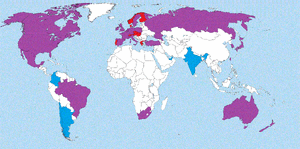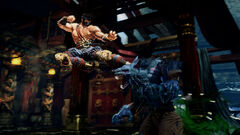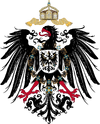
|
This is a featured alternate history!
Ohga Shrugs is a featured timeline, which means it has been identified as one of the best alternate histories produced by the alternate history community. If you see a way this alternate history can be updated or improved without compromising previous work, please say so on this page's talkpage. |
This is a technological alternate history. In short, the PlayStation brand is never created, keeping both Sega and Nintendo the main players in the game console market through the current day, and limiting the expansion of the Video Game Console market.
Concept[]
The PlayStation brand is an oddity in video game history. Whereas Nintendo entered the video game console market as an outgrowth of their involvement in the toys industry, and Microsoft got involved to protect their multimedia interests, Sony got involved due to a grudge.
In 1991, Nintendo and Sony had made a deal to collaborate on a CD-ROM attachment for the then-new SNES. When Nintendo embarrassed Sony by backing out of the deal without telling them first, Sony's president Norio Ohga was so outraged that he provided the funding to create a new console to compete with them.
This timeline asks the question "What if Ohga shrugged it off?"
Enter a world where video gaming is still a largely niche hobby, where Sega and Nintendo remain the dueling masters of the market, where series like Gran Turismo and Gears of War never existed, where the relatively obscure franchises like Mother have become big names, where Final Fantasy was a Nintendo exclusive for two decades.
Welcome to Ohga Shrugs.
Current Events[]
- August 28, 2013 - Nintendo announces a new handheld gaming console, entitled "Game Boy 2DS". Set for a release in North America, Europe, Australia and New Zealand on October 12, 2013, the Game Boy 2DS is an entry-level version of the Game Boy 3DS which maintains compatibility with software designed for the Game Boy Nitro and the Game Boy 3DS, but uses a new "slate"-like design (instead of the clamshell design used by its precursors) and lacks the Game Boy 3DS's autostereoscopic 3D functionality.
- August 23, 2013 - Shinobi Eclipse is released exclusively for the Eclipse.
- August 20, 2013 - Splinter Cell: Blacklist is released for the eighth generation of consoles. It is considered a re-invigoration of the series, bringing back the original emphasis on stealth the Splinter Cell games were known for.
- August 15, 2013 - HarmoKnight, a new music/action game from the creators of Pokemon, is released as a retail game in Japan. The game is scheduled for a holiday release in the West.
- July 25, 2013 - Ace Attorney 5 is released for the Game Boy 3DS in Japan.
- July 20, 2013 - Pikmin 3 is released for the Nintendo Stream.
- July 12, 2013 - Mario & Luigi: Dream Team is released for the Game Boy 3DS. On the same day, the original Game Boy 3DS's price is cut to $170.
- June 11, 2013 - E3 2013 is held. The first E3 of the new generation, this event is dominated by Nintendo, which shows off games such as Pikmin 3, Super Mario 3D Bros, Super Smash Bros 4, Mario Kart Stream, Donkey Kong Country: Tropical Freeze, Stream Fitness, and Stream Party for the Stream and Mario & Luigi: Dream Team, Pokemon X/Y, The Legend of Zelda: A Link Between Worlds, a handheld version of Super Smash Bros 4, Ice Climber Ascent 2, and Mario: Bowser City for the Game Boy 3DS. In addition, the original Game Boy 3DS's first major price cut is announced. Sega has a good showing though, with exclusives including Sonic: Lost World, Bayonetta 2, Shinobi Eclipse, and Sonic at the Sochi Olympic Games for the Eclipse. Third party games shown include Assassin's Creed: Black Flag, Watch Dogs, and multiple Tom Clancy games from Ubisoft, Batman: Arkham Origins and Scribblenauts: Unmasked from Warner Bros, Final Fantasy 15, Kingdom Hearts 3, and Final Fantasy 10 3D from Square, Dead Rising 3 from Capcom, Call of Duty: Ghosts and Skylanders: Swap Force from Activision, Castlevania: Lords of Shadow 2 and Metal Gear Solid 5 from Konami, and a console version of Diablo 3 from Blizzard..
- May 23, 2013 - Shin Megami Tensei 4 is released for the Game Boy 3DS.
- April 26, 2013 - Virtua Tennis 5 is released for the Eclipse.
- April 23, 2013 - Tomb Raider is released for the eighth generation consoles and the PC. It is very well regarded, but sales are somewhat below expectations.
- March 20, 2013 - Mario Party 3D is released for the Game Boy 3DS.
- March 12, 2013 - Killer Instinct 3 is released for the Stream.
- February 19, 2013 - Ubisoft releases Rayman Legends for the eighth generation consoles. The game receives immediate critical acclaim.
- February 14, 2013 - Dragon Quest 7 is released for the Game Boy 3DS. A remake of the N64 classic, this game becomes one of the first notable RPG's on the system.
- February 12, 2013 - After a long wait, Sega releases Aliens: Colonial Marines. The game receives poor reviews, and is considered a major loss for the young Eclipse.
- January 31, 2013 - DmC: Devil May Cry is released for the Revolution, Pluto, Stream, and Eclipse. The game receives decent reviews but fairly low sales, even selling across four platforms.
- January 7, 2013 - Tom Fulp announces a fundraiser for Extra Life, in cooperation with The Behemoth. The top hundred donors over the next three months before the game's release would have their names featured within the game. The names would be added to the final product via a patch that would also fix any technical issues.
- December 15, 2012 - The Sega Eclipse is launched in Japan. Launch Titles include Sega Superstars Smackdown: Strife, Sonic & All-Stars Racing Transformed, and the star of the Launch Ryu ga Gotoku 5: Yume Kanaeshi Mono (Yazuka 5: Those who Create Dreams)
- December 8, 2012 - The Nintendo Stream is launched in Japan. A port of Monster Hunter 3 called Monster Hunter 3 Ultimate is released on both the Stream and the Game Boy 3DS on the same day, with cross-platform functionality. The game ends up being successful enough here to warrant a worldwide release in 2013.
- December 6, 2012 - Paper Mario: Sticker Star is released for the Game Boy 3DS. The game controversially forgoes many traditional RPG elements, instead opting for an inventory-based combat system.
- November 30, 2012 - The Nintendo Stream is launched in Europe.
- November 23, 2012 - The Sega Eclipse is launched in Europe.
- November 21, 2012 - A new Game Boy 3DS model, called the "XL," is announced by Nintendo.
- November 18, 2012 - The Nintendo Stream is launched in North America. Launch games include New Super Mario World, Pokemon Snap 2, and Assassin's Creed III.
- November 11, 2012 - The Sega Eclipse is launched in North America. Launch titles include Sonic & All-Stars Racing Transformed and Assassin's Creed III.
- November 1, 2012 - Animal Crossing: New Leaf is released in Japan. The game is a massive hit, outselling even other big names on the Game Boy 3DS such as Mario.
- October 30, 2012 - Assassin's Creed 3 is released for the Pluto and Revolution. An improved version of the game is ported to the new consoles the following month. Need for Speed: Most Wanted is released the same day.
- October 10, 2012 - Skylanders Giants is released for all major platforms.
- October 2, 2012 - Resident Evil 6 is released for the Revolution and Pluto. Originally thought to be a grand finale for the entire console generation, the game is something of a critical miss, despite healthy sales. NBA 2K13 is released the same day.
Summary[]
Fourth Generation[]

The winner of the Fourth Generation.
Although the point of divergence is fairly early in the fourth generation of consoles, very little changes for the first few years. Nintendo and Sega are the primary competitors on the market with the Super Nintendo and the Genesis as their respective consoles. Although Sega starts off strong, Nintendo finishes ahead thanks to Sega's expensive and poorly supported peripherals like the 32X and Sega CD, while Nintendo saved some of their strongest games, the Donkey Kong Country series, for latter years.
Meanwhile, Nintendo decisively defeats Sega on the handheld front. Despite the relatively impressive specs of the Game Gear compared to the Game Boy, the latter ended up selling several times as well. Despite launching later, the Game Gear was discontinued first.
Fifth Generation[]
The fifth generation of console games had its origin in the arcades. In 1993 and 1994, a number of impressive arcade titles, particularly Sega's own Virtua Fighter, helped convince games developers to emphasize 3D graphics when new consoles came to market. Ironically, Sega included 3D support for their next system, the Saturn, relatively late on. This limited 3D support compared to the N64 meant that many early 3D games would incorporate 2D backgrounds, environments, and objects.
Sega released the Saturn in late 1995 at a price of about $300 worldwide, followed by Nintendo releasing the Nintendo 64 the next year. In general, the Saturn received the bulk of third-party support for this generation, though some companies such as Square and Enix would remain loyal to Nintendo. This was due to the relatively low cost of Saturn CD-ROMs compared to N64 cartridges.
Major games of this era included Nintendo's first and second party games like Super Mario 64 and Ocarina of Time, which helped define how 3D environments could be navigated in games; Tomb Raider and Resident Evil, 3D action series that made their start around this time; Final Fantasy 7, the game that sold the JRPG to Western audiences; Crash Bandicoot and Spyro the Dragon, which largely replace Sonic in his absence on the Saturn; Goldeneye, the first popular console FPS; and Metal Gear Solid, which pushed forward cinematic elements in games.
Meanwhile, the Game Boy line went largely unopposed. The Sega Nomad unsuccessfully tried to find a place in the market, while Pokemon gave the original Game Boy a final hurrah. In 1998, Nintendo began phasing it out for the Game Boy Color, which was capable of playing more advanced games, including NES ports.
Although arcades remained popular in this era, their decline was undeniable. This was due to the increasing power of consoles compared to arcade machines, and the impressive roster of arcade-style games on consoles, especially the Saturn. However, this decline was softened somewhat by games like the Tekken series and Ridge Racer, which never received console counterparts.
Sixth Generation[]

Possibly the hardcore gamer's favorite console of all time.
Once again, Sega released their next system, the Dreamcast, a year before its Nintendo competitor, the GameCube. The Dreamcast was based off of NAOMI arcade hardware, and was largely identical, making porting games from one t the other very simple. The GameCube, meanwhile, featured a second analog stick and a faster CPU, although it had less RAM. However, as neither console used full-sized DVDs, games were limited to under 1.5 GB.
Third party support was largely split this generation, due to the similar nature of the two machines. However, series like Metal Gear Solid and Devil May Cry were exclusive to the Dreamcast while Square's Final Fantasy and Kingdom Hearts games were GameCube exclusives. In general, the Dreamcast received more Action and Sports games while the GameCube received more RPGs, although there were plenty of exceptions.
If the fifth generation was one of revolution, than the sixth was one of refinement. Due to the limited size of Dreamcast and GameCube discs, the scale of games scarcely increased, or even decreased thanks to the more advanced graphics overtaking memory.
The Game Boy line continued with the Advance model, which was similar in specs to the SNES. It featured many SNES ports over its life, and became the system of choice for many old-school gamers. The Pokemon games also continued to be popular, although less so than previously.
Arcades continued their slow death this generation, with record lows constantly being reported. However, a comparatively large number of games continued to be released for NAOMI hardware in particular, thanks to the ease of porting those games to the Dreamcast. Thus, the arcades became a place to preview upcoming titles before their inevitable Dreamcast release.
Seventh Generation[]
This generation began with the release of the innovative Game Boy Nitro, which famously had one of the first touch screens used on a gaming device. The Nitro was released with much fanfare in early 2006, with strong Nintendo support and, by the end of its first year of life, plenty of third party support as well. The Nitro easily went on to become the best selling gaming device of all time, despite rising competition from mobile devices.
Meanwhile on the console front, both Nintendo and Sega released their next generation systems in November 2006. Although the two systems were largely similar, save for online strategies, Nintendo soon got ahead of Sega using their stronger first party lineup, selling games that appealed to broader audiences, receiving a lot of third party support formerly exclusive to Sega, and selling in regions previously outside of the main gaming market, such as Eastern Europe, Latin America and various Asian countries where the Game Boy line had given Nintendo some presence.
The main changes in games of the era were open worlds, made possible by the full-sized DVD-style discs and more powerful hardware, and online play, which started on the Dreamcast, but exploded during this era.
Video game arcades all but died out in this generation, as the continued rise of online console play destroyed much of the remaining community of arcade patrons.
Eighth Generation[]

A map showing the countries where Sega and Nintendo have headquarters worldwide. Blue countries have only Sega headquarters, Red countries have only Nintendo headquarters, and purple countries have both. Note Nintendo's relative strength in Europe versus Sega's in South America.
The eighth generation of gaming hardware began in 2011, when the Game Boy 3DS was released late in the year and the two consoles were released in November 2012. The two consoles were largely evolved forms of their predecessors, albeit with a greater emphasis on non-gaming applications. The most innovative system of the era was the Game Boy 3DS, which revolutionized gaming visuals by adding a second 3D screen to the Game Boy handhelds.
Sales Figures[]
Fourth Generation[]
Over its life, the Sega Genesis sold four million units in Japan, 17 million units in America, and ten million units elsewhere to sell a total of 31 million units over its life. The Super Nintendo sold 19 million units in Japan, 25 million units in America, and ten million units elsewhere for a total of 54 million units sold throughout its life. The sales of individual games released this generation are similar to those in real life.
Fifth Generation[]
Sega's standing improved over the course of this generation, largely at the expense of Nintendo's. The Sega Saturn sold ten million units in Japan, 20 million units in America, and 12 million units elsewhere for a total of 42 million units sold worldwide. The Nintendo 64, meanwhile, sold 15 million units in Japan, but sold 27 million units in America and eight million in other parts of the world for a total of 50 million units.
On the Saturn, the best selling game was Virtua Fighter 2, with about seven million copies sold. Furthermore, another 29 titles sold at least two million units, including other Virtua games, Crash Bandicoot games, and Resident Evil games, and a total of 86 titles broke a million units. In total, the approximately 1200 titles for the Saturn sold 300 million units.
On the Nintendo 64, more games sold many millions of copies, but there were less games that sold over a million units. Nintendo games like Super Mario 64, Mario Kart 64, Goldeneye 007, and The Legend of Zelda: Ocarina of Time sold over ten million units each, but only 65 games sold at least a million copies. Still, in total, the 600 N64 games released sold a combined total of 400 million games.
Sixth Generation[]
Once again, Sega grew somewhat this generation, while Nintendo remained largely stagnant. In total, 11 million Dreamcasts were sold in Japan, 21 million were sold in America, and 15 million were sold elsewhere, for a total of 47 million units of hardware sold. The GameCube only sold slightly more, with 11 million units of hardware sold in Japan, 28 million sold in America, and ten million sold elsewhere, for a total of 49 million.
The best selling games for the Dreamcast were Sonic Adventure 1 and 2, which sold about seven and five million units, respectively. Other games that sold three million or more units included Metal Gear Solid 2 and 3, a few Madden and Tony Hawk games, and Super Monkey Ball 1 and 2. In total, the Dreamcast had 94 games sell at least a million units, and the estimated 1300 Dreamcast games sold a combined total of 400 million units.
The GameCube, meanwhile, continued the Nintendo trend of having fewer games total selling better individually. The only console game of the generation to break ten million units was Mario Kart: Double Dash, which sold 15 million. Games in the five to ten million range included both iterations of Nintendo games like Metroid Prime and Super Smash Bros Melee and Final Fantasy games. In total, 1100 games were made for the GameCube, and they sold a total of 450 million games.
Seventh Generation[]
The seventh generation was marked by significant growth, especially by Nintendo in areas outside of America and Japan. As of the end of 2012 the Sega Pluto has sold three million units in Japan, 21 million in America, 18 million in Europe, and nine million other parts of the world for a total of 51 million, whereas the Nintendo Revolution has sold 11 million units in Japan, 32 million in America, 32 million in Europe, and 12 million elsewhere for a total of about 86 million.
Eighth Generation[]
Both the Stream and Eclipse launched with healthy numbers, and are expected to sell at least three million units combined by the end of 2012. Early sales numbers show the two consoles selling roughly on par with each other. The Game Boy 3DS sold 14 million copies in 2012.
Links[]
| ||||||||||||||||||||
| ||||||||||||||||||||||




